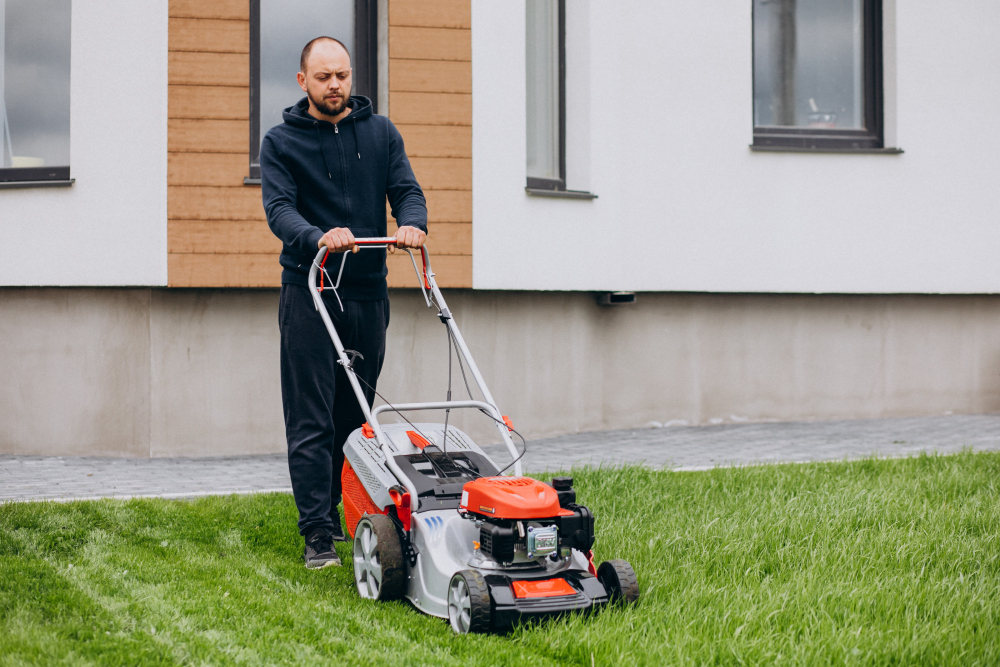Are you dreaming of a lush, green lawn that’s the envy of the neighborhood? Achieving and maintaining a healthy lawn requires more than just occasional mowing and watering. It requires a combination of proper care, attention to detail, and consistency. In this comprehensive guide, we’ll explore eight essential tips for healthy lawn maintenance to help you grow and take care of your lawn that you can enjoy year-round.
Before diving into our tips for healthy lawn, let’s first discuss the importance of regular mowing, edging, and blowing because they are the backbone of a well-maintained lawn. Regular mowing not only keeps your grass looking neat and tidy but also promotes healthy growth and prevents weed infestations.
Regarding importance of regular edging – it creates clean, defined borders that enhance the overall appearance of your lawn and landscaping. Meanwhile, the importance of regular blowing is that it blows away debris like leaves and grass clippings ensuring that your lawn stays clean and free of obstructions, allowing it to breathe and thrive.
Together, these practices form the foundation for a beautiful and healthy lawn.

1. Choose the Right Grass Type
The first tip for a healthy lawn is all about foundation. It starts with selecting the right grass type for your region and climate. Different grass varieties thrive in different conditions, so it’s essential to choose one that is well-suited to your area’s temperature, rainfall, and soil type. Conduct research or consult with a local lawn care expert to determine the best grass species for your lawn.
2. Proper Mowing Techniques
The importance of regular mowing is evident when it comes to lawn maintenance. But, proper mowing is crucial for maintaining a healthy lawn. Avoid cutting your grass too short, as this can stress the grass and make it more susceptible to disease and weed infestations. Instead, follow the one-third rule: never remove more than one-third of the grass blade length at a time. Additionally, vary your mowing patterns regularly to prevent soil compaction and encourage even growth.
3. Watering Wisely
Watering is the most essential tip for healthy lawn as it keeps your lawn hydrated and healthy, but it’s important to water wisely. Avoid overwatering, as this can lead to shallow root growth and fungal diseases. Instead, water deeply and infrequently, allowing the soil to dry out slightly between waterings. Water your lawn early in the morning to reduce evaporation and minimize the risk of fungal growth.
4. Fertilize Regularly
Fertilizing provides your lawn with essential nutrients that promote healthy growth and development. Choose a high-quality, slow-release fertilizer specifically formulated for your grass type and apply it according to the manufacturer’s instructions. Be sure to fertilize in the spring and fall when your lawn is actively growing, and avoid fertilizing during periods of drought or heat stress.
5. Weed Control Strategies
Weed control stands out among the important tips for healthy lawn maintenance! Weeds can quickly take over your lawn if left unchecked, so it’s essential to implement effective weed control strategies. Regularly inspect your lawn for weeds and remove them promptly by hand or with a weeding tool. Additionally, consider using pre-emergent herbicides to prevent weed seeds from germinating and post-emergent herbicides to target existing weeds.
Here
6. Aerating and Overseeding
Aerating and overseeding are essential lawn care tasks that help improve soil compaction and promote healthy grass growth. Aerating involves removing small plugs of soil from your lawn to allow air, water, and nutrients to penetrate the soil more easily. Overseeding involves spreading grass seed over your existing lawn to fill in bare patches and improve overall density.
7. Managing Pests and Diseases
Managing pests and diseases is crucial among the tips for healthy lawn maintenance. Pests and diseases can wreak havoc on your lawn if left unchecked, so it’s important to stay vigilant and address any issues promptly. Keep an eye out for signs of pest infestations, such as chewed leaves or discolored patches, and treat affected areas with appropriate pesticides or insecticidal soaps. Similarly, be on the lookout for signs of lawn diseases, such as brown patches or fungal growth, and take steps to prevent their spread.
8. Seasonal Lawn Care Checklist
Finally, develop a seasonal lawn care checklist to ensure that you’re staying on top of essential maintenance tasks throughout the year. In the spring, focus on aerating, overseeding, and fertilizing. In the summer, prioritize watering, and know about the importance of regular mowing, and pest control. In the fall, continue to mow and water as needed, and prepare your lawn for the winter months by removing debris and applying a winterizing fertilizer.
All in all, the importance of regular edging, the importance of regular mowing, and importance of regular blowing are sincerely considered in a seasonal lawn care checklist. These tasks help maintain the overall appearance and health of the lawn throughout the year, ensuring that it remains tidy and free of debris.
Achieving and maintaining a healthy lawn requires dedication, effort, and a bit of know-how, but the results are well worth it. By following these eight essential tips, you can grow and maintain a lush, green lawn that enhances your outdoor space and provides a beautiful backdrop for all your outdoor activities.
FAQs
How often should I mow my lawn for optimal health?
Mowing frequency depends on the grass type and growth rate, but generally, you should mow your lawn once a week during the growing season to maintain optimal health and appearance.
What is the best time of day to water my lawn?
The best time to water your lawn is early in the morning, between 6 AM and 10 AM, to reduce evaporation and minimize the risk of fungal growth.
How can I prevent weeds from taking over my lawn?
Prevent weeds by regularly inspecting your lawn, using pre-emergent herbicides to stop weed seeds from germinating, and maintaining a thick, healthy lawn that crowds out weeds naturally.
